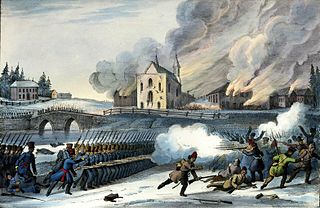
The Lower Canada Rebellion, commonly referred to as the Patriots' War in French, is the name given to the armed conflict in 1837–38 between rebels and the colonial government of Lower Canada. Together with the simultaneous rebellion in the neighbouring colony of Upper Canada, it formed the Rebellions of 1837–38.

This section of the Timeline of Quebec history concerns the events in British North America relating to what is the present day province of Quebec, Canada between the time of the Constitutional Act of 1791 and the Act of Union 1840.
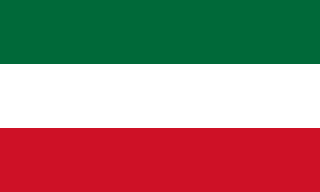
The Parti canadien or Parti patriote was a primarily francophone political party in what is now Quebec founded by members of the liberal elite of Lower Canada at the beginning of the 19th century. Its members were made up of liberal professionals and small-scale merchants, including François Blanchet, Pierre-Stanislas Bédard, John Neilson, Jean-Thomas Taschereau, James Stuart, Louis Bourdages, Denis-Benjamin Viger, Daniel Tracey, Edmund Bailey O'Callaghan, Andrew Stuart and Louis-Joseph Papineau.

John Neilson was a journalist, publisher and politician in Lower Canada. Born in Scotland, he emigrated to Lower Canada in 1791 at age 15, to work in his older brother's publishing company in Quebec City. On his brother's death a few years later, he inherited the business. Neilson became one of the leading publishers and booksellers in Lower Canada and in Upper Canada, selling books in both French and English. He was the editor of the newspaper La Gazette de Québec / The Quebec Gazette, published in French and in English.

Le Canadien was a French language newspaper published at various times in Lower Canada, then the Province of Canada, and finally the province of Quebec, at various times in the 19th century. It went through three different publication phases, with interruptions in publishing.
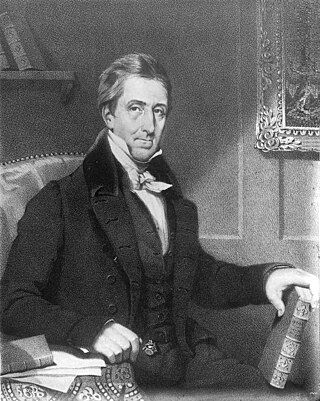
Denis-Benjamin Viger was a 19th-century politician, lawyer, and newspaper publisher in Lower Canada, who served as joint premier of the Province of Canada for over two years. A leader in the Patriote movement, he was a strong French-Canadian nationalist, but a social conservative in terms of the seigneurial system and the position of the Catholic church in Lower Canada.
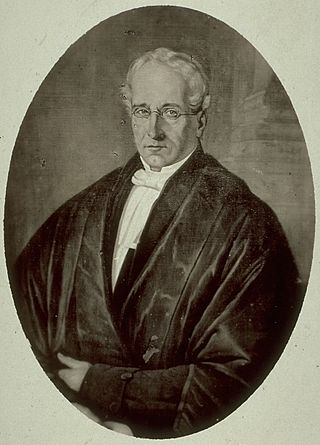
Austin Cuvillier was a businessman and political figure in Lower Canada and Canada East. He was a successful Canadien businessmen, unusual when most businessmen in Lower Canada were British. He also was a member of the Legislative Assembly of Lower Canada for twenty years, as a member for the Parti canadien, which tended to oppose the policies of the British-appointed governors. As a result, he served as a bridge between the conservative business community, and the more radical Parti canadien, although he finally broke with the Parti canadien prior to the Lower Canada Rebellion of 1837–1838.

Étienne Parent was a Canadian journalist, politician and government official. A French-Canadian nationalist, he wrote extensively on political theory and governance during the 1820s and 1830s in various newspapers, particularly Le Canadien, of which he was editor. He was attracted to theories of constitutional governance based on the British constitution, and opposed annexation to the United States. Born to farming parents, he spent most of his adult life in the French-Canadian political and social elites.

Joseph-Édouard Turcotte was a lawyer, businessman, and political figure in Canada East. Born to a merchant family, he considered the priesthood, but after the loss of one arm in an accident, he opted instead for a legal career. In addition to the law, he was engaged in journalism and in business activities in Trois-Rivières.
Thomas Boutillier was a doctor, Patriote, and politician in Lower Canada. Elected to the Legislative Assembly of Lower Canada in 1834, he was a member of the Parti patriote led by Louis-Joseph Papineau, which was challenging the British colonial government of the largely French-speaking province of Lower Canada. When the Lower Canada Rebellion broke out in 1837, he fought on the Patriote side in the Battle of Saint-Charles. Following the Patriotes' defeat, he fled to the United States. He returned to Lower Canada in 1838.
Amable Berthelot was a Canadien lawyer, author and political figure. He was elected to the Legislative Assembly of Lower Canada and later to the Legislative Assembly of the Province of Canada. Trained as a lawyer, he was an avid book-collector, at one point having a personal library of some fifteen hundred volumes. He did not support those who took up arms during the Lower Canada Rebellion of 1837–1838. He never married, but adopted two children, a boy and a girl. His daughter married Louis-Hippolyte LaFontaine, later co-premier of the Province of Canada. He was a literary mentor to François-Xavier Garneau.
Jean-Moïse Raymond was a businessman, militia officer and political figure in Lower Canada, and briefly in Canada East, in the Province of Canada. He was active in a family business inherited from his father, and also served in the Lower Canada militia during the War of 1812, at the Battle of the Châteauguay. As a member of the Legislative Assembly of Lower Canada, he was critical of British government of the province, voting in favour of the Ninety-Two Resolutions, which set out a detailed list of problems with the government. He opposed the union of Lower Canada with Upper Canada. Following the union of those two provinces into the Province of Canada, he was elected to the Legislative Assembly of the new province, but resigned his seat after only one year to take a government appointment. He died in 1843.

Louis-Michel Viger was a lawyer, banker, businessman, seigneur and political figure in Lower Canada, and then in Canada East in the Province of Canada.
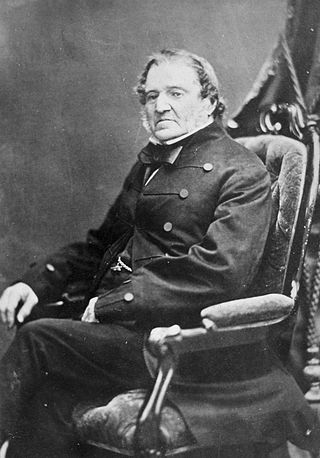
Frédéric-Auguste Quesnel,, was a lawyer, businessman and politician in Lower Canada. He was a member of the Legislative Assembly and the Executive Council of Lower Canada. Following the union of the Canadas, he was elected to the Legislative Assembly of the Province of Canada and later was appointed to the Legislative Council. Throughout his career he was a political moderate, seeking greater political power for French-Canadians under British rule, but also supporting the British connection generally. Condemned by the Patriotes as a vendu ("sell-out") in the Lower Canada Rebellion, in 1860 he was elected President of the Saint-Jean-Baptiste Society of Montreal.

Jean-Antoine Panet was a notary, lawyer, judge, seigneur and political figure in Lower Canada.
The 12th Parliament of Lower Canada was in session from January 8, 1825, to July 5, 1827. Elections to the Legislative Assembly in Lower Canada had been held in July 1824. All sessions were held at Quebec City.
The 15th Parliament of Lower Canada was in session from March 21, 1835, to March 27, 1838. Elections to the Legislative Assembly in Lower Canada had been held in October 1834. The lower house was dissolved following the Lower Canada Rebellion and Lower Canada was administered by an appointed Special Council until the Act of Union in 1840 established a new lower chamber for the Province of Canada. All sessions were held at Quebec City.
René-Joseph Kimber was a physician and political figure in Lower Canada and Canada East, in the Province of Canada. He represented Trois-Rivières in the Legislative Assembly of Lower Canada, as a member of the Parti patriote, although he opposed the use of force in the Lower Canada Rebellion. After the creation of the Province of Canada, which he opposed, he was the member for the district of Champlain in the Legislative Assembly of the Province of Canada. He was briefly a member of the Legislative Council, prior to his death in 1843.

The patriotes movement was a political movement that existed in Lower Canada from the turn of the 19th century to the Patriote Rebellion of 1837 and 1838 and the subsequent Act of Union of 1840. The partisan embodiment of the movement was the Parti patriote, which held many seats in the Legislative Assembly of Lower Canada.

Louis Panet was a notary and political figure in Quebec. He sat for La Salle division in the Senate of Canada from 1871 to 1874. Panet also represented La Salle in the Legislative Council of Quebec from 1867 to 1884.













